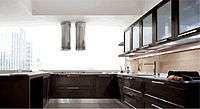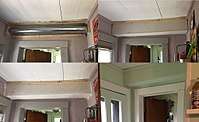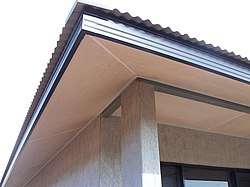Soffit
A soffit is an exterior or interior architectural feature, generally the horizontal, aloft underside of any construction element. Its archetypal form, sometimes incorporating or implying the projection of beams, is the underside of eaves (to connect a retaining wall to projecting edge(s) of the roof). In many parts of the English-speaking world surveyors, property writers and builders have preferred the specialism of the term to architecture rather than terms seen in other industries and settings so have employed it to cover the exposed plane of framework infilling such as coving or the vertical face to fill the space between the ceiling and the top of inbuilt cabinets, to incorporate sections of false wall and, at perhaps its most strained, the face of false ceilings.


Etymology
The term soffit is from French: soffite, formed as a ceiling; and directly from suffictus for suffixus, Latin: suffigere, to fix underneath).
Soffits in homes and offices
In architecture, soffit is the underside (but not base) of any construction element.
Examples include:
| Description | More precise synonym |
|---|---|
| undersurface or under-face of any overhanging section of a roof eave | |
| underside of a cornice | |
| underside of a flight of stairs, under the classical entablature | |
| framework-filled area beneath kink of a chimney | undercroft of chimney |
| wall into which loudspeakers are mounted in a recording studio | wall with speaker recesses |
| curvature of e.g. plasterwork to fill the space above the kitchen cabinets, at the corner of the ceiling and wall | coving (interior design) |
| underside of office ceiling of tiles (often gypsum) suspended, fastened or bonded to a grid system attached to the walls and/or ceiling | false/suspended ceiling (tiles/grid) |
| underside of an arch or architrave (whether supported by piers or columns) | underarches |
| lower (usually false) ceiling area to mask and allow egress of upper end of ventilation hood(s)/flues[1] | false ceiling/lower ceiling beneath (multi-light/surround) lantern/raised skylight/dome/sloped upper ceiling |
Under the eaves of a roof
In foremost use soffit is the first definition in the table above. In spatial analysis, it is one of the two necessary planes of any (3-dimensional) optionally built area, eaves, which projects, for such area to be within the building's space.
In 2-dimensional face analysis it is a discrete face almost always parallel with the ground that bridges the gap(s) between a building's siding (walls) and either: their parallel extraneous plane (fascia) where such exists; or where no such plane, a point along (or the abrupt end of) the roof's outer projection (overhang). Soffits and fascias are archetypally screwed or nailed to rafters known as lookout rafters or lookouts for short, their repair being often undertaken simultaneously. A parapet wall or cornice tend to preclude eaves, as an alternate design, both favouring flat roofs and weather-proof walls. Very pronounced overhangs (eaves) are characteristic to European architecture to shield the walls from rain, sleet and snow such as Swiss chalet style, Dutch, Romanian, and Tudor architecture.
Soffit exposure profile (from wall to fascia) on a building's exterior can vary from a few centimetres (2–3 inches) to 3 feet or more, depending on construction. It can be non-ventilated or ventilated, to prevent condensation. A grill that covers the venting opening on the bottom of the soffit is called a soffit vent. A soffit joist can be added to the framework instead of or in addition to lookouts.
See also
References
- "Range Hood Installation Under Sloped / High Ceiling". Futuro Futuro. Retrieved 15 November 2012.


